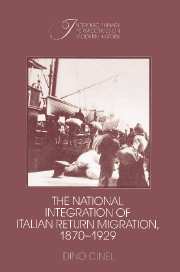Book contents
- Frontmatter
- Contents
- Acknowledgments
- Introduction: Emigration and the process of national integration
- 1 The difficult task of national integration
- 2 A blueprint for change
- 3 The southern ethos
- 4 The national debate
- 5 Return migration
- 6 American remittances
- 7 Investing American savings
- 8 Regional differences
- 9 Return and retirement
- Conclusion: National integration and return migration
- Notes
- Index
- Frontmatter
- Contents
- Acknowledgments
- Introduction: Emigration and the process of national integration
- 1 The difficult task of national integration
- 2 A blueprint for change
- 3 The southern ethos
- 4 The national debate
- 5 Return migration
- 6 American remittances
- 7 Investing American savings
- 8 Regional differences
- 9 Return and retirement
- Conclusion: National integration and return migration
- Notes
- Index
Summary
The national debate on emigration was based on the assumption that the phenomenon would be temporary and that virtually all emigrants would return to Italy. But when consuls began to send reports to Rome that increasing numbers of Italians were becoming citizens of Western Hemisphere nations and relinquishing the idea of returning, the government became alarmed and tried to prevent temporary emigration from becoming permanent through legislative measures. Even the language used by the Italian Bureau of Statistics in elaborating its data shows that emigrants were expected to return. According to the bureau, there were two types of emigration: temporary and permanent. Temporary was the emigration of less than one-year duration; permanent was the emigration of several years. But there was no category to classify individuals relocating abroad permanently.
The return of Italians from international destinations and especially from overseas is important for several reasons. First, the popular assumption, especially among Americans, is that the transatlantic emigration of Europeans was a one-way movement. The popular mythology linked to the image of America as a nation of immigrants, the ideology of American exceptionalism and its corollary that every person who set foot on American soil believed himself so fortunate that returning to the native country was unthinkable, and the need to celebrate the advancement of ethnics in America were reasons for focusing on permanent immigrants. Historical accuracy, however, and a more balanced view of the transatlantic movement as a process of mutual enrichment between the United States and Europe compel us to pay attention also to the millions of Europeans who returned.
- Type
- Chapter
- Information
- Publisher: Cambridge University PressPrint publication year: 1991

